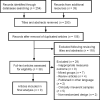Transcranial direct current stimulation for auditory verbal hallucinations: a systematic review of clinical trials
- PMID: 33063718
- PMCID: PMC8067931
- DOI: 10.4103/1673-5374.295315
Transcranial direct current stimulation for auditory verbal hallucinations: a systematic review of clinical trials
Abstract
Transcranial direct current stimulation (tDCS) has been reportedly beneficial for different neurodegenerative disorders. tDCS has been reported as a potential adjunctive or alternative treatment for auditory verbal hallucination (AVH). This study aims to review the effects of tDCS on AVH in patients with schizophrenia through combining the evidence from randomized clinical trials (RCTs). The databases of PsycINFO (2000-2019), PubMed (2000-2019), EMBASE (2000-2019), CINAHL (2000-2019), Web of Science (2000-2019), and Scopus (2000-2019) were systematically searched. The clinical trials with RCT design were selected for final analysis. A total of nine RCTs were eligible and included in the review. Nine RCTs were included in the final analysis. Among them, six RCTs reported a significant reduction of AVH after repeated sessions of tDCS, whereas three RCTs did not show any advantage of active tDCS over sham tDCS. The current studies showed an overall decrease of approximately 28% of AVH after active tDCS and 10% after sham tDCS. The tDCS protocols targeting the sensorimotor frontal-parietal network showed greater treatment effects compared with the protocols targeting other regions. In this regard, cathodal tDCS over the left temporoparietal area showed inhibitory effects on AVHs. The most effective tDCS protocol on AVHs was twice-daily sessions (2 mA, 20-minute duration) over 5 consecutive days (10 sessions) with the anode over the left dorsolateral prefrontal cortex and the cathode over the left temporal area. Some patient-specific and disease-specific factors such as young age, nonsmoking status, and higher frequencies of AVHs seemed to be the predictors of treatment response. Taken together, the results of tDCS as an alternative treatment option for AVH show controversy among current literatures, since not all studies were positive. However, the studies targeting the same site of the brain showed that the tDCS could be a promising treatment option to reduce AVH. Further RCTs, with larger sample sizes, should be conducted to reach a conclusion on the efficacy of tDCS for AVH and to develop an effective therapeutic protocol for clinical setting.
Keywords: auditory verbal hallucinations; dorsolateral prefrontal cortex; effective protocol; randomized clinical trial; schizophrenia; temporoparietal area; transcranial direct current stimulation; treatment efficacy.
Conflict of interest statement
None
Figures
References
-
- Andrade C. Once- to twice-daily, 3-year domiciliary maintenance transcranial direct current stimulation for severe, disabling, clozapine-refractory continuous auditory hallucinations in schizophrenia. J ECT. 2013;29:239–242. - PubMed
-
- Andreasen NC, Flaum M. Schizophrenia: the characteristic symptoms. Schizophr Bull. 1991;17:27–49. - PubMed
LinkOut - more resources
Full Text Sources
Other Literature Sources


